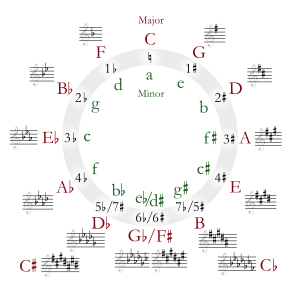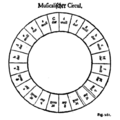Circle of fifths facts for kids
The Circle of Fifths is a cool way to understand how different musical keys are connected. Imagine a circle with all the musical keys placed around it. It helps musicians see how keys relate to each other. If you pick a key on the circle, the key to its right is its "fifth." This idea is often easier to grasp if you think about a piano keyboard.
Contents
How Music Keys Work
On a piano, you see both white and black notes. People sometimes call these "keys" too, which can be a bit confusing! The white notes are named using letters from A to G. After G, the notes start over again with A.
The black notes are grouped in sets of two and three. This pattern helps you easily spot the white notes. For example, the white note between two black notes is always D. Black notes don't have their own unique names. Instead, they get their names from the white notes next to them.
Sharps and Flats
A black note just above (to the right) of a G is called G sharp. A black note just below (to the left) of a G is called G flat. This means that each black note can have two possible names. For instance, the same black note can be called G flat or F sharp.
Playing Scales
If you play every note in order, both white and black, you create a chromatic scale. For example, starting from C, you would play C, C sharp, D, E flat, E, F, F sharp, G, A flat, A, B flat, B, and then back to C. Each step from one note to the next is called a "semitone" or "half tone." A "tone" or "whole tone" is a jump of two semitones. So, C to D is a tone, or C sharp to E flat is a tone.
When you play only the white notes from C to the next C, you get a major scale. In a major scale, some steps are tones and some are semitones. The semitones always happen between the 3rd and 4th notes, and between the 7th and 8th notes of the scale. All major scales follow this same pattern: tone, tone, semitone, tone, tone, tone, semitone.
Sharper Keys
Let's look at some examples of how keys get "sharper":
- If you start a major scale on G, the F note in that scale needs to be an F sharp. This F sharp is important for the key of G major.
- If you start a major scale on D, both the F and the C notes need to be F sharp and C sharp.
- If you start a major scale on A, then F, C, and G all need to be sharp.
- You can keep going like this until all seven notes in the scale are sharp. This key is called C sharp major.
Each time we moved to a key with more sharps, we picked the note that was the 5th note of the previous scale. For example, G (with one sharp) was the 5th note of C major. D (with two sharps) was the 5th note of G major, and so on.
This pattern is what the "Circle of Fifths" shows. As keys get sharper, you move clockwise around the circle.
Flatter Keys
Keys with "flats" work in the opposite way. Instead of going up a fifth (like C to G), you go down a fifth (like C to F). F major is the scale that has one flat. As keys get flatter, you move counter-clockwise around the circle. You can keep going until all seven notes are flattened.
Some keys can be called by two different names. For example, B major (which has 5 sharps) sounds the same as C flat major (which has seven flats). F sharp major (with 6 sharps) is the same as G flat major (with 6 flats). And C sharp major (with 7 sharps) is the same as D flat major (with 5 flats).
Minor Keys
The Circle of Fifths can also help you find "relative minor" keys. A relative minor scale shares the exact same sharps or flats as its major key partner. To find a relative minor, you can go three steps counter-clockwise around the circle. For example, C major is the relative major of A minor. They both have no sharps or flats. On a piano, you can find the relative minor by going down three semitones from the major key's starting note. From C, you go down to B, then B flat, then A.
Images for kids
-
Heinichen's musical circle (German: Musicalischer Circul) (1711)
See also
 In Spanish: Círculo de quintas para niños
In Spanish: Círculo de quintas para niños




